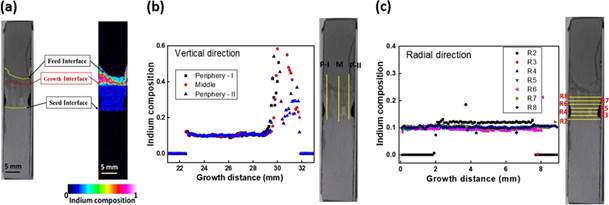InxGa1-xSb Crystal with High Indium Concentration is First Grown in Space
The homogeneous InxGa1-xSb crystal with the indium content as high as 11% (x = 0.11) has been prepared for the first time. It was achieved by the research team from Shanghai Institute of Ceramics, Chinese Academy of Sciences led by Prof. YU Jianding through the space crystal growth experiment. The result was published in NPJ Microgravity( DOI:10.1038/s41526-019-0068-1).
The absorption wavelength and lattice constant of InxGa1-xSb can be controlled in the range of 1.7–6.8 μm and 6.096–6.479 by adjusting the indium composition, respectively. It was calculated that In0.11Ga0.89Sb has the wavelength of 2 μm. Thus it is a potential material for the PV cell to fabricate the TPV device with Al2O3 emitter to convert thermal radiation to electricity. However it is very difficult to grow homogeneous InxGa1-xSb crystal with a large separation between the solidus and liquidus lines under normal gravity due to the buoyancy convection caused by the gravity. On the contrary, microgravity helps to achieve a higher growth rate and compositional homogeneity at higher indium composition of InxGa1-xSb solid solution.
In April 2016, China’s first recoverable satellite for microgravity science experiment was launched. The crystal growth of In0.11Ga0.89Sb on microgravity was carried out by a multi-functional material furnace boarded on the satellite. The crystal was grown for more than 60 hours by using a vertical gradient freezing method. After the satellite returning to earth, the research team, cooperating with ISAS of Japan, systematically analyzed the composition and structure of the crystal by Electron Microscope (EM), Electron Probe Microanalyzer (EPMA) and Electron Backscattered Diffraction (EBSD).
The results showed that the shape of the growth interface was almost parallel at the onset and end of the growth; the growth rate of the crystals was 0.145mm/h; In0.11Ga0.89Sb crystal with a length of about 7.1mm was grown, and the indium composition in crystal was 0.11, which was uniformly distributed in the growth area of the crystal.
The research was funded by the priority research program of CAS, etc.
The article links: https://www.nature.com/articles/s41526-019-0068-1

Indium composition of In0.11Ga0.89Sb under microgravity.
a EPMA mapping, b along vertical direction, and c along radial direction (growth region) (Imaged by YU Jianding)
Contact:
Prof. YU Jianding
Shanghai Institute of Ceramics



